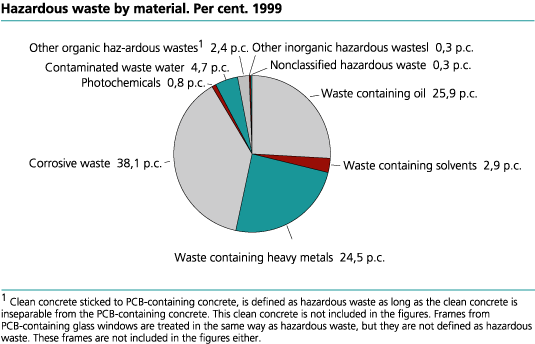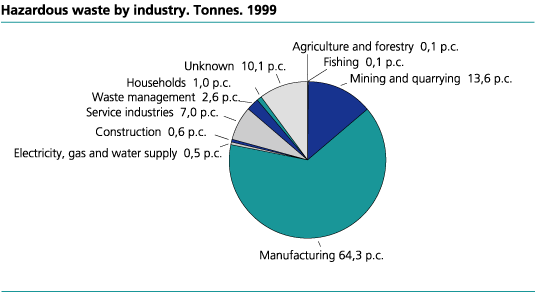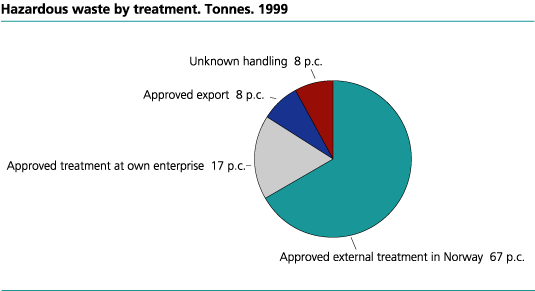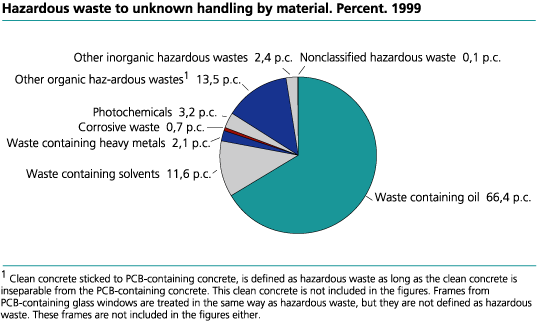Content
Published:
This is an archived release.
Considerable amounts of hazardous waste to unknown handling
New calculations by Statistics Norway show that about 631 000 tonnes of hazardous waste were generated in Norway in 1999. Approximately 50 000 tonnes of this were handled in an unknown way, which is far more than earlier assumed. Additionally more than 170 000 tonnes of dangerous waste, but not formally defined as hazardous waste, were generated. This makes the total amount of waste harmful to humans or the environment about 800 000 tonnes.
Hazardous waste is waste with a serious potential of injury to human health or pollution to the environment. It is therefore of high importance that such waste is being handled securely. To ensure secure handling the authorities introduced the hazardous waste regulation in 1984. This regulation defines and classifies hazardous waste, and regulates storing, delivering and handling of such waste. All kinds of hazardous wastes must undergo approved treatment and must be reported to the authorities.
92 per cent to approved treatment
Of the 631 000 tonnes of hazardous waste generated in Norway in 1999, 581 000 tonnes were treated as endorsed in the hazardous waste regulation. This is at the same level as in 1996 and 1997 but about 100 000 tonnes less than in 1998. Corrosive waste and waste containing oil or heavy metals together account for close to 90 per cent of all hazardous waste in Norway in 1999.
Most from chemical industry and metal industry
406 000 tonnes of hazardous waste were registered from manufacturing industries, of which about 90 per cent came from either chemical industry or metal industry. Near 60 per cent of the registered hazardous waste from manufacturing industries were corrosive (acids or bases) while 30 per cent were slags containing heavy metals. From mining and quarrying there was registered 86 000 tonnes of hazardous waste. This came almost exclusively from extraction of oil and gas and consisted of near two third oil-containing wastes and near one third contaminated wastewater. 43 000 tonnes of hazardous waste were registered from service industries, of which 81 per cent were oil containing waste. Retail trade (including petrol stations and small tank plants) generated 56 per cent of the hazardous waste from the service industries, while transport industries generated 27 per cent.
The infrastructure of waste treatment and waste registering in Norway makes it difficult to achieve an accurate distribution of the hazardous waste by industry. Some of the hazardous waste may have been registered on the service industries through the municipal waste system, even though the actual establishments of origin represent other industries. The same situation applies to hazardous waste registered from waste handling. For the service industries this is, according to amounts, of minor importance. For waste handling the data material indicates that as much as 20 per cent of the hazardous waste may have originated from other industries (see "About the statistics" for details). Some of the hazardous waste categorised as "unknown industry" originates from building and construction industry. This comprises mainly PCB-containing waste. It can be assumed that the real share of hazardous waste from building and construction industry therefore lies between 1,5 and 2 per cent. Hazardous waste specified under unknown industry consists mainly of 50 000 tonnes to unknown handling and 13 000 tonnes of lead batteries collected through a separate return scheme.
Hazardous waste should only be treated on specifically constructed plants approved by the Pollution Control Authority (SFT). Hazardous waste generated in Norway is mainly transported to and treated at approved plants in Norway. Totally 421 000 tonnes of hazardous waste were handled as approved in 1999. NOAH AS is the most important treatment establishment with its plants at Langøya near Holmestrand, where most of the Norwegian hazardous waste is treated to inert solids and subsequently finally disposed, and in Brevik, where huge amounts of organic hazardous waste is pretreated and sent for energy recovery at a neighbour plant.
A total of 110 000 tonnes of hazardous waste were disposed internal at the establishments of origin in 1999. This is approximately 60 000 tonnes less than in 1998. Internal disposal is almost exclusively taking place in the manufacturing industry and embraces mainly wastes containing heavy metals.
Slightly more than 50 000 tonnes of hazardous waste was exported in 1999. This is nearly twice as much than in 1998, when 26 000 tonnes of hazardous waste was exported. About half of the exported hazardous waste is contaminated wastewater from oil industry, in excess of one quarter is lead batteries collected through a separate return scheme. Slightly more than 60 per cent of the export took place directly from the plant of origin. Only hazardous waste sent for recycling or for which there is no alternative treatment in Norway can be exported legally.
50 000 tonnes to unknown handling
The new calculations from Statistics Norway show that about 50 000 tonnes of hazardous waste were handled in ways unknown to the authorities in 1999. This is as much as 20 000 tonnes more than what Norsas estimated in 1994, and which has been regarded as the prevailing estimate until today. One explanation of the high amount can be that establishments handling their hazardous waste securely have failed to report this to the authorities. Furthermore, some hazardous waste may be stored in the plants for several years. Still it cannot be disregarded that a substantial part of the 50 000 tonnes is astray and thereby treated illegally. The most widespread ways of illegal handling are assumed to be disposal of hazardous waste in ordinary municipal waste systems, discharges to the sewer system (for example through oil separators), illegal export and dumping in the environment.
and 90 per cent of this is organic hazardous waste
66 per cent of the hazardous waste going to unknown handling were waste oil and other oil containing waste. The most important sources are believed to be service industries like shipping and other transport, car workshops, petrol stations and defence activities. Some of the waste may also have come from extraction of oil and gas, agriculture and fishing.
In the category "other organic hazardous waste", 6 800 tonnes went to unknown handling. Of this about 6 700 tonnes were PCB-containing waste. In addition there were 100 tonnes of pesticides. The PCB-containing hazardous waste was mainly glass and concrete from demolition and rehabilitation of buildings. The pesticides came mainly from households.
The amount of solvent-containing hazardous waste going to unknown handling was 5 800 tonnes. Of this, paint wastes constituted 3 600 tonnes and solvent wastes 2 200 tonnes. The paint waste came mainly from professional painters and households, while the solvent waste came mainly from households, condemning of cars and dry-cleaners. The calculations on solvent waste to unknown handling are somewhat incomplete. It could thus exist other sources than those mentioned here.
The estimate is conservative
The estimate of 50 000 tonnes of hazardous waste to unknown handling must be regarded as a conservative estimate. There are several reasons for that. Firstly, one important group of hazardous waste is omitted in the calculations, namely hazardous waste defined because of its harmful properties (carcinogenic, harmful to the environment, causing allergies, etc.) but not specifically listed in the hazardous waste regulation. To calculate the amounts of this kind of hazardous waste extensive additional investigations are required. Secondly, as mentioned above, the calculations on solvents are incomplete. It must be assumed that for instance car workshops and professional painters may have some solvent waste astray, but this is not included in the calculations. Thirdly, clean concrete stuck to PCB-containing concrete, is defined as hazardous waste in so far as the clean concrete is inseparable from the PCB-containing concrete. This clean concrete is not included in the calculations. Fourthly, the calculations of hazardous waste to unknown handling from the manufacturing industry are based on a survey in which it is up to the establishments themselves to report the amounts of hazardous waste generated, also amounts subject to illegal handling. Establishments handling hazardous waste illegally may naturally have objections to report this in a statistical survey. Additional uncertainty is described in "About the statistics".
Other wastes harmful to health or the environment
Some types of waste are harmful to the environment and/or human health without being official defined as hazardous waste. The reasons for this are partly that they have not been considered as sufficiently harmful to be classified as hazardous waste, and partly that they are embraced by other specific regulations. This includes amongst others infectious, radioactive and explosive waste.
At least 140 000 tonnes of electric or electronic waste (EE-waste) are generated each year, but only 45 per cent of this is collected through return schemes. The amount of hazardous waste in EE-waste constitutes about 2 000 tonnes. This amount is however included in the hazardous waste calculations above. The amount of preserved wood waste is estimated to 19 500 tonnes in 2000, of which 12 500 tonnes are preserved with creosote and 7 000 tonnes are preserved with CCA-salt. Preserved wood waste was not classified as hazardous waste in 1999 but is in a grey sone because of its content of heavy metals and tar substances. Asbestos waste accounts for at least 10 000 tonnes in addition to what is classified as hazardous waste. The far most of this is asbestos cement (sheeting, etc.), and a considerable amount is assumed handled illegally.
Calculations show that the amount of infectious waste in 2000 was about 2 000 tonnes, of which. 99 per cent were either disinfected or incinerated. Medicine waste is collected to Norsk Medisinaldepot (Norway's biggest pharmaceuticals wholesaler) through the chemist's shops or is sent directly to incineration plants from the hospitals. Norsk Medisinaldepot receives and sends for incineration about 250 tonnes of discarded medicines each year. The amount sent directly to incineration from the hospitals is not calculated and comes in addition. It must also be assumed that some medicine waste is consigned to the household waste and ends up in landfills or is flushed into the sewer.
Radioactive waste accounts for almost 60 tonnes annually, of which about one half is packaging. The difference in radiation intensity and lifetime for the different isotopes is substantial. Therefore the amounts do not alone give sufficient information about the real environmental hazards. Institute for Energy Technology (Institutt for Energiteknikk) can be contacted for more information.
Explosive waste makes in order of magnitude 2 - 3 tonnes per year from non-defence activities. To this must be added explosive waste from defence activities internally handled within the military. These amounts are not calculated.
Tables:
Additional information
Approved treatment as applied in this article includes only hazardous waste generated in Norway (export is therefore included, while import is excluded).
Contact
-
Gisle Berge
E-mail: gisle.berge@ssb.no
tel.: (+47) 48 12 19 97
-
Terje Lorentzen Landsem
E-mail: terje.landsem@ssb.no
tel.: (+47) 98 84 31 39




